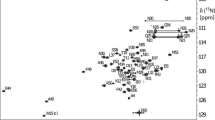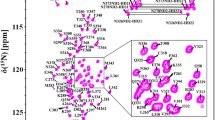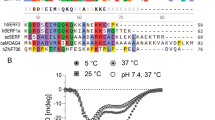Abstract
Brain acid-soluble protein 1 (BASP1, CAP-23, NAP-22) appears to be implicated in diverse cellular processes. An N-terminally myristoylated form of BASP1 has been discovered to participate in the regulation of actin cytoskeleton dynamics in neurons, whereas non-myristoylated nuclear BASP1 acts as co-suppressor of the potent transcription regulator WT1 (Wilms’ Tumor suppressor protein 1). Here we report NMR chemical shift assignment of recombinant human BASP1 fused to an N-terminal cleavable His6-tag.
Similar content being viewed by others
Biological context
The homologues of human BASP1 were first identified as the brain-specific proteins CAP-23 (cortical cytoskeleton-associated protein) in chicken brain (Widmer and Caroni 1990) and its rat homologue NAP-22 (neuron-specific acidic protein; Maekawa et al. 1993). Human BASP1 was originally isolated from neuronal cells (Mosevitsky 2005). Interestingly it appears to fulfill quite diverse tasks in the cell. N-myristoylated BASP1 has been described to be involved in neurite outgrowth and plasma membrane organization (Korshunova et al. 2008). It is able to interact with the inner leaflet of the plasma membrane via its myristoyl-anchor and sequesters Phosphatidyl-inositol-4,5-diphosphate (PIP2) into lipid rafts (Epand et al. 2004; Shaw et al. 2006). Recently it has been shown that liposomes containing anionic phospholipids induce oligomerization of BASP1. Interaction with calmodulin is followed by dissociation of BASP1 from the membrane and disruption of the oligomers (Zakharov and Mosevitsky 2010). Additionally, BASP1 is under the control of protein kinase C (PKC), which phosphorylates BASP1 at Ser5. It is hypothesized that phosphorylation leads to the disruption of the interaction of the N-terminal positive effector domain of BASP1 with anionic phospholipids (Laux et al. 2000).
Furthermore, non-myristoylated BASP1 appears to influence transcription regulation in the nucleus, greatly affecting the differentiation pathway of a cell. It has been discovered as a co-suppressor of WT1 function (Wilms’ Tumor suppressor protein 1) exerting its function by interacting with an N-terminal suppression domain of WT1 (Carpenter et al. 2004; Green et al. 2009). WT1 itself is a potent transcriptional regulator that activates or represses target genes including those for growth factors and regulators of cell division (Wagner and Roberts 2004). Aberrant expression of WT1 is associated with several childhood and adult cancers (Rivera and Haber 2005; Yang et al. 2007). Additionally, a recent study discovered BASP1 to be downregulated in v-Myc-transformed chicken fibroblasts. Strikingly, ectopic expression of BASP1 renders fibroblasts resistant to subsequent cell transformation by v-Myc and it has been shown that the inhibition of v-Myc-induced cell transformation by BASP1 affects the transcriptional regulation of Myc target genes (Hartl et al. 2009). Other findings, reporting the frequent down-regulation of BASP1 expression in ALL (acute lymphocytic leukaemia) and CLL (chronic lymphocytic leukaemia) (Yeoh et al. 2002; Wang et al. 2004), as well as apoptosis-induced cleavage of BASP1 and its subsequent translocation to the cytoplasm (Ohsawa et al. 2008), again highlight the importance of BASP1 in transcription regulation.
To provide molecular information about this potential tumour suppressor protein we have started the NMR structure determination of recombinant human BASP1. The near complete chemical shift assignment reveals that BASP1 belongs to the class of intrinsically disordered proteins.
Methods and results
Protein expression and purification
The coding region for hBASP1 (human BASP1) was amplified by PCR from the mammalian expression vector Flag-hBASP1-pTKX3 (Ohsawa et al. 2008) introducing a 5′ NcoI and 3′ NotI site. Subsequently the fragment was inserted in-frame into the NcoI and NotI sites of the bacterial expression vector pET-M11 (Pinotsis et al. 2006), yielding pET-M11-hBASP1, encoding hBASP1 fused to an N-terminal His6-tag plus the TEV-cleavage site (H6-hBASP1). 15N/13C labeled H6-hBASP1 was expressed in the E. coli strain Rosetta(DE3)pLysS following a new expression protocol for efficient isotopic labeling of recombinant proteins using a fourfold cell concentration in isotopically labeled minimal medium (Marley et al. 2001). The cells were collected after 4 h of expression at 37 °C by centrifugation at 5,000 rpm for 15 min and resuspended in 40 ml of ice-cold lysis buffer (20 mM NaxH(3−x)PO4, 50 mM NaCl, 10 mM imidazole, pH 7.2) per liter of the original bacterial culture. Bacteria were lysed by passing through a French press, and the cell lysate was cleared by centrifugation at 18,000 rpm for 20 min. The supernatant containing the soluble protein fraction was loaded onto a Ni2+ loaded HiTrap 5 ml affinity column (GE Healthcare), washed with 2 column volumes of high salt buffer (20 mM NaxH(3−x)PO4, 1.5 M NaCl, 10 mM imidazole, pH 7.2) and eluted with high imidazole buffer (20 mM NaxH(3−x)PO4, 50 mM NaCl, 0.5 M imidazole, pH 7.2) using a linear gradient of 15 column volumes. The H6-hBASP1 containing fractions were collected and the buffer was exchanged by 4 steps of concentration in an Amicon Ultra-15 centrifugal filter device 10 K NMWL (Amicon) and subsequent dilution in target buffer (20 mM NaxH(3−x)PO4, 50 mM NaCl, pH 6.0). NMR samples contain 1.5 mM uniformly 15N/13C labeled protein in 20 mM sodium phosphate (pH 6.0, in 90 % H2O and 10 % D2O), 50 mM NaCl and 0.2 % sodium azide.
NMR experiments
All spectra were acquired at 298 K on an Agilent Direct Drive 700 MHz spectrometer using the standard 5 mm 1H–13C–15N triple-resonance probe head.
The backbone 1H, 13C and 15N resonances were assigned using sparse random sampling of indirectly detected time domains, in order to increase resolution. A 3D HNCO experiment was used as a base spectrum for SMFT (Sparse Multidimensional Fourier Transform) processing of higher dimensionality experiments (Kazimierczuk et al. 2010). Backbone assignment was achieved using 5D HN(CA)CONH (Kazimierczuk et al. 2010), (HACA)CON(CA)CONH (Zawadzka-Kazimierczuk et al. 2012b), (H)NCO(NCA)CONH (Zawadzka-Kazimierczuk et al. 2012b) and HNCOCACB (Zawadzka-Kazimierczuk et al. 2012b) experiments. Side-chain assignments were obtained using 5D HabCabCONH (Kazimierczuk et al. 2010), and H(CC-tocsy)CONH (Kazimierczuk et al. 2009) experiments.
All NMR data sets were processed by multidimensional Fourier transformation using the home written software package (http://nmr700.chem.uw.edu.pl/formularz.html). The resonance assignment was performed using the TSAR program (Zawadzka-Kazimierczuk et al. 2012a). The input data for TSAR was prepared using Sparky software (Goddard and Kneller 2002). Table 1 shows the maximum evolution times and spectral width used for the acquisition of the spectra.
Extent of assignment and data deposition
The 1H–15N HSQC spectrum of H6-hBASP1 shows a very narrow peak dispersion in the 1H dimension typical for intrinsically disordered proteins (Fig. 1). Extensive signal overlap in conventional 2D & 3D spectra could be overcome by using the aforementioned 5D experiments. 99 % of backbone 15N, 99.5 % of 1HN, 96.5 % of 13Cα, 74 % of 1Hα, 86.2 % of 13Cβ, 81.4 % of 1Hβ and 98.7 % of 13C′ resonances have been assigned. Additionally, H(CC-tocsy)CONH spectra allowed the assignment of several side-chain atoms. Figure 2 shows sample strips of sequential resonance assignment in a 5D (HACA)CON(CA)CONH and HN(CA)CONH experiment. Secondary chemical shifts for 13C′, 13Cα, 1Hα (Fig. 3) show only minor deviations from random coil chemical shift values. Interestingly, the N-terminus appears to harbour stretches with slight α-helical structure propensities, whereas the rest of the protein seems to adopt a rather extended conformation indicated by positive 1Hα chemical shift differences.
Secondary chemical shifts for a 13C′, b 13Cα, and c 1Hα using sequence-specific random coil chemical shifts of intrinsically disordered proteins (Tamiola et al. 2010)
The 1H, 13C and 15N chemical shifts have been deposited in the BioMagResBank (http://www.bmrb.wisc.edu/) under the BMRB accession number 18417.
References
Carpenter B, Hill KJ, Charalambous M, Wagner KJ, Lahiri D, James DI, Andersen JS, Schumacher V, Royer-Pokora B, Mann M, Ward A, Roberts SG (2004) BASP1 is a transcriptional cosuppressor for the Wilms’ tumor suppressor protein WT1. Mol Cell Biol 24(2):537–549
Epand RM, Vuong P, Yip CM, Maekawa S, Epand RF (2004) Cholesterol-dependent partitioning of PtdIns(4,5)P2 into membrane domains by the N-terminal fragment of NAP-22 (neuronal axonal myristoylated membrane protein of 22 kDa). Biochem J 379(Pt 3):527–532. doi:10.1042/BJ20040204
Green LM, Wagner KJ, Campbell HA, Addison K, Roberts SG (2009) Dynamic interaction between WT1 and BASP1 in transcriptional regulation during differentiation. Nucleic Acids Res 37(2):431–440. doi:10.1093/nar/gkn955
Hartl M, Nist A, Khan MI, Valovka T, Bister K (2009) Inhibition of Myc-induced cell transformation by brain acid-soluble protein 1 (BASP1). Proc Natl Acad Sci USA 106(14):5604–5609. doi:10.1073/pnas.0812101106
Kazimierczuk K, Zawadzka A, Kozminski W (2009) Narrow peaks and high dimensionalities: exploiting the advantages of random sampling. J Magn Reson 197(2):219–228. doi:10.1016/j.jmr.2009.01.003
Kazimierczuk K, Zawadzka-Kazimierczuk A, Kozminski W (2010) Non-uniform frequency domain for optimal exploitation of non-uniform sampling. J Magn Reson 205(2):286–292. doi:10.1016/j.jmr.2010.05.012
Korshunova I, Caroni P, Kolkova K, Berezin V, Bock E, Walmod PS (2008) Characterization of BASP1-mediated neurite outgrowth. J Neurosci Res 86(10):2201–2213. doi:10.1002/jnr.21678
Laux T, Fukami K, Thelen M, Golub T, Frey D, Caroni P (2000) GAP43, MARCKS, and CAP23 modulate PI(4,5)P(2) at plasmalemmal rafts, and regulate cell cortex actin dynamics through a common mechanism. J Cell Biol 149(7):1455–1472
Maekawa S, Maekawa M, Hattori S, Nakamura S (1993) Purification and molecular cloning of a novel acidic calmodulin binding protein from rat brain. J Biol Chem 268(18):13703–13709
Marley J, Lu M, Bracken C (2001) A method for efficient isotopic labeling of recombinant proteins. J Biomol NMR 20(1):71–75
Mosevitsky MI (2005) Nerve ending “signal” proteins GAP-43, MARCKS, and BASP1. Int Rev Cytol 245:245–325. doi:10.1016/S0074-7696(05)45007-X
Ohsawa S, Watanabe T, Katada T, Nishina H, Miura M (2008) Novel antibody to human BASP1 labels apoptotic cells post-caspase activation. Biochem Biophys Res Commun 371(4):639–643. doi:10.1016/j.bbrc.2008.04.056
Pinotsis N, Petoukhov M, Lange S, Svergun D, Zou P, Gautel M, Wilmanns M (2006) Evidence for a dimeric assembly of two titin/telethonin complexes induced by the telethonin C-terminus. J Struct Biol 155(2):239–250. doi:10.1016/j.jsb.2006.03.028
Rivera MN, Haber DA (2005) Wilms’ tumour: connecting tumorigenesis and organ development in the kidney. Nat Rev Cancer 5(9):699–712. doi:10.1038/nrc1696
Shaw JE, Epand RF, Sinnathamby K, Li Z, Bittman R, Epand RM, Yip CM (2006) Tracking peptide-membrane interactions: insights from in situ coupled confocal-atomic force microscopy imaging of NAP-22 peptide insertion and assembly. J Struct Biol 155(3):458–469. doi:10.1016/j.jsb.2006.04.015
Tamiola K, Acar B, Mulder FA (2010) Sequence-specific random coil chemical shifts of intrinsically disordered proteins. J Am Chem Soc 132(51):18000–18003. doi:10.1021/ja105656t
Wagner KJ, Roberts SG (2004) Transcriptional regulation by the Wilms’ tumour suppressor protein WT1. Biochem Soc Trans 32(Pt 6):932–935. doi:10.1042/BST0320932
Wang J, Coombes KR, Highsmith WE, Keating MJ, Abruzzo LV (2004) Differences in gene expression between B-cell chronic lymphocytic leukemia and normal B cells: a meta-analysis of three microarray studies. Bioinformatics 20(17):3166–3178. doi:10.1093/bioinformatics/bth381
Widmer F, Caroni P (1990) Identification, localization, and primary structure of CAP-23, a particle-bound cytosolic protein of early development. J Cell Biol 111(6 Pt 2):3035–3047
Goddard TD, Kneller DG (2002) SPARKY 3. University of California, San Francisco
Yang L, Han Y, Suarez Saiz F, Minden MD (2007) A tumor suppressor and oncogene: the WT1 story. Leukemia 21(5):868–876. doi:10.1038/sj.leu.2404624
Yeoh EJ, Ross ME, Shurtleff SA, Williams WK, Patel D, Mahfouz R, Behm FG, Raimondi SC, Relling MV, Patel A, Cheng C, Campana D, Wilkins D, Zhou X, Li J, Liu H, Pui CH, Evans WE, Naeve C, Wong L, Downing JR (2002) Classification, subtype discovery, and prediction of outcome in pediatric acute lymphoblastic leukemia by gene expression profiling. Cancer Cell 1(2):133–143
Zakharov VV, Mosevitsky MI (2010) Oligomeric structure of brain abundant proteins GAP-43 and BASP1. J Struct Biol 170(3):470–483. doi:10.1016/j.jsb.2010.01.010
Zawadzka-Kazimierczuk A, Kozminski W, Billeter M (2012a) TSAR a program for automatic resonance assignment using cross-sections of high dimensionality, high-resolution spectra. J Biomol NMR 54:81–95. doi:10.1007/s10858-012-9652-3
Zawadzka-Kazimierczuk A, Kozminski W, Sanderova H, Krasny L (2012b) High dimensional and high resolution pulse sequences for backbone resonance assignment of intrinsically disordered proteins. J Biomol NMR 52:329–337. doi:10.1007/s10858-012-9613-x
Acknowledgments
The authors thank Professor Masayuki Miura for providing the Flag-hBASP1-pTKX3 plasmid (Ohsawa et al. 2008). All NMR experiments were carried out in the Structural Research Laboratory at the Faculty of Chemistry, University of Warsaw. This work was supported by the EAST-NMR project (contract no. 228461) inside of a transnational access program (proposal acronym: SEQUASSIGNIUPBASP1) and by the Grant P 20549-N19 from the Austrian Science Foundation FWF. A.Z.-K. thanks the Foundation for Polish Science for supporting her with the MPD Programme, S.S., S.Ż, and W.K. thank the Foundation for Polish Science for support with the TEAM Programme. MPD and TEAM programs were co-financed by the EU European Regional Development.
Open Access
This article is distributed under the terms of the Creative Commons Attribution License which permits any use, distribution, and reproduction in any medium, provided the original author(s) and the source are credited.
Author information
Authors and Affiliations
Corresponding author
Rights and permissions
Open Access This article is distributed under the terms of the Creative Commons Attribution 2.0 International License (https://creativecommons.org/licenses/by/2.0), which permits unrestricted use, distribution, and reproduction in any medium, provided the original work is properly cited.
About this article
Cite this article
Geist, L., Zawadzka-Kazimierczuk, A., Saxena, S. et al. 1H, 13C and 15N resonance assignments of human BASP1. Biomol NMR Assign 7, 315–319 (2013). https://doi.org/10.1007/s12104-012-9436-4
Received:
Accepted:
Published:
Issue Date:
DOI: https://doi.org/10.1007/s12104-012-9436-4







